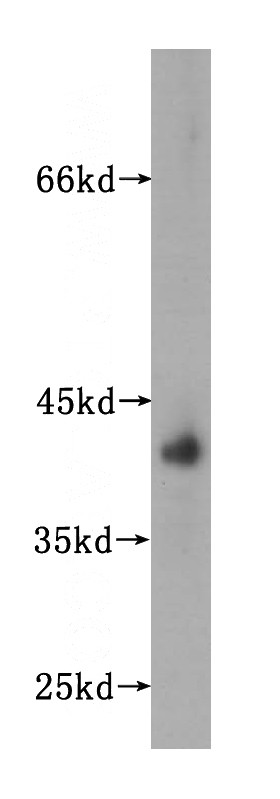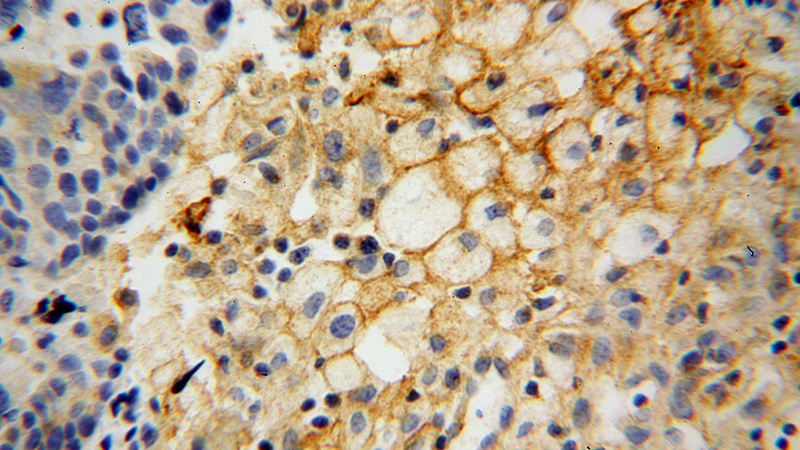-
Product Name
HSD17B2 antibody
- Documents
-
Description
HSD17B2 Rabbit Polyclonal antibody. Positive IHC detected in human ovary tumor tissue. Positive WB detected in human liver tissue, MCF7 cells. Observed molecular weight by Western-blot: 35-40 kDa
-
Tested applications
ELISA, WB, IHC
-
Species reactivity
Human; other species not tested.
-
Alternative names
17 beta HSD 2 antibody; 17βHSD2 antibody; 20 alpha HSD antibody; E2DH antibody; EDH17B2 antibody; HSD17 antibody; HSD17B2 antibody; SDR9C2 antibody
-
Isotype
Rabbit IgG
-
Preparation
This antibody was obtained by immunization of HSD17B2 recombinant protein (Accession Number: NM_002153). Purification method: Antigen affinity purified.
-
Clonality
Polyclonal
-
Formulation
PBS with 0.1% sodium azide and 50% glycerol pH 7.3.
-
Storage instructions
Store at -20℃. DO NOT ALIQUOT
-
Applications
Recommended Dilution:
WB: 1:200-1:2000
IHC: 1:20-1:200
-
Validations

human liver tissue were subjected to SDS PAGE followed by western blot with Catalog No:111546(HSD17B2 antibody) at dilution of 1:400

Immunohistochemical of paraffin-embedded human ovary tumor using Catalog No:111546(HSD17B2 antibody) at dilution of 1:100 (under 10x lens)

Immunohistochemical of paraffin-embedded human ovary tumor using Catalog No:111546(HSD17B2 antibody) at dilution of 1:100 (under 40x lens)
-
Background
HSD17B2(Estradiol 17-beta-dehydrogenase 2) is also named as 17-beta-HSD 2,20-alpha-HSD,EDH17B2 and belongs to the short-chain dehydrogenases/reductases (SDR) family.Based on the pivotal role of HSD17B2 gene product in the estrogen metabolism pathway, it may be considered as a putative candidate gene that could possibly explain a fraction of the remaining familial breast cancer risk and it is unlikely to play a role as a high penetrance gene in breast cancer predisposition(PMID:18372405).
-
References
- Aghajanova L, Hamilton A, Kwintkiewicz J, Vo KC, Giudice LC. Steroidogenic enzyme and key decidualization marker dysregulation in endometrial stromal cells from women with versus without endometriosis. Biology of reproduction. 80(1):105-14. 2009.
- Shen Z, Saloniemi T, Rönnblad A, Järvensivu P, Pakarinen P, Poutanen M. Sex steroid-dependent and -independent action of hydroxysteroid (17beta) Dehydrogenase 2: evidence from transgenic female mice. Endocrinology. 150(11):4941-9. 2009.
- Wang J, Qin R, Ma Y. Differential gene expression in normal esophagus and Barrett's esophagus. Journal of gastroenterology. 44(9):897-911. 2009.
- Chen N, Sun W, Deng X. Quantitative proteome analysis of HCC cell lines with different metastatic potentials by SILAC. Proteomics. 8(23-24):5108-18. 2008.
- Plante J, Simard M, Rantakari P. Epithelial cells are the major site of hydroxysteroid (17beta) dehydrogenase 2 and androgen receptor expression in fetal mouse lungs during the period overlapping the surge of surfactant. The Journal of steroid biochemistry and molecular biology. 117(4-5):139-45. 2009.
- Takagi K, Miki Y, Nagasaki S. Increased intratumoral androgens in human breast carcinoma following aromatase inhibitor exemestane treatment. Endocrine-related cancer. 17(2):415-30. 2010.
- Margarit L, Taylor A, Roberts MH. MUC1 as a discriminator between endometrium from fertile and infertile patients with PCOS and endometriosis. The Journal of clinical endocrinology and metabolism. 95(12):5320-9. 2010.
- Sasaki Y, Miki Y, Hirakawa H. Immunolocalization of estrogen-producing and metabolizing enzymes in benign breast disease: comparison with normal breast and breast carcinoma. Cancer science. 101(10):2286-92. 2010.
Related Products / Services
Please note: All products are "FOR RESEARCH USE ONLY AND ARE NOT INTENDED FOR DIAGNOSTIC OR THERAPEUTIC USE"
